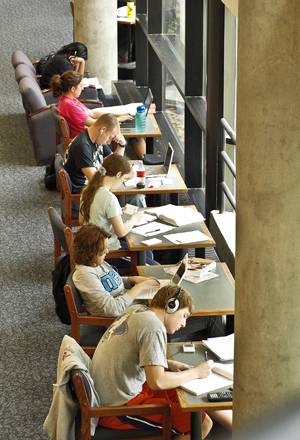Studying in same place may help students

People find a quiet place to study in Parks Library, on Sunday October 12, 2008. Photo: Molly McKernan/Iowa State Daily
October 14, 2008
As the weather gets colder, students have to shift their activities indoors — Central Campus and the Lagomarcino courtyard will no longer be a place to study, but there are many campus buildings left to utilize.
Craig Chatriand, interim assistant director of the Academic Success Center and graduate student in educational leadership and policy studies, said students should find a spot to study that accommodates their needs.
“Studies show that consistency and familiarity that comes with studying in a regular spot does help students do better in school,” Chatriand said. “There are many places on campus, such as study rooms in Hixon-Lied, residence hall lounges, ISU Dining cafes and common spaces in all buildings.”
Katherine Barwacz, freshman in elementary education, is a student who has a regular study spot.
“Between classes I like to come to the cafe in Lagomarcino to study by myself, and during the nights I go to the library and study with friends,” Barwacz said.
Wesley Klejch, sophomore in pre-med, also likes to study outside of his dorm — during the day he studies in the Browsing Library of the Memorial Union and at night in the Hixon-Lied building, where he mostly goes for study groups.
“Another thing students should try is working in study groups,” Chatriand said. “In addition, students shouldn’t find friends to study with, but they should make a group with other students who are doing well in the class.”
While study groups are a good way to review, there are many other ways.
Edward Leonard, freshman in mechanical engineering, likes to take cornell notes. Cornell notes are two-sided notes — on one side you write questions and on the other side you write the answers to the questions.
“I was introduced to cornell notes in my sophomore year of high school, and I have used them ever since,” Leonard said. Cornell notes help Leonard review by asking himself questions written on one side and having the answers on the other side to help him refresh his memory.
Another way to review is by taking practice exams. For Klejch’s Biology 211 class, he needs to prepare well in advance before exam time.
“It is not a class you can cram the night before,” Klejch said. The exams from previous years help Klejch understand what kinds of questions will be on the exam while testing his knowledge.
Many study habits can help students, but there can be distractions.
“Ten years ago, there was a craze for video games,” Chatriand said. “Many can argue that today the main distractions are cell phones and online Web sites, such as Facebook.”
Chatriand advised students to turn off cell phones and close Facebook while working.
“Students can even schedule Facebook into their day,” Chatriand said. “Students can take a break in between studying and check Facebook for a short break. If students feel tempted to stay on Facebook, they should ask themselves: ‘What am I going to miss?’”
With midterms happening, Chatriand said students should seek help immediately if they need it. For studying tips and academic help, many resources are available for students.
“There are many learning communities and organizations that offer subsidized tutoring, such as Women in Science and Engineering and [Multicultural Student Affairs],” Chatraind said.
Supplemental Instruction is available for many classes. According to the Academic Success Center’s Web site, SI offers ‘three to five 50-minute sessions using collaborative learning methods’ every week, which are led by SI leaders.”
“Our studies show that students who attend SI do half to a full letter grade better than students who do not,” Chatraind said.






